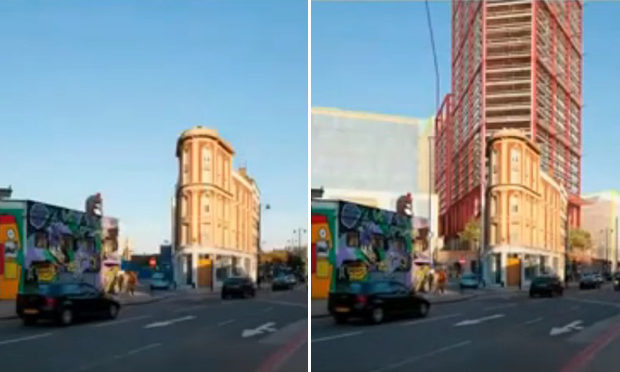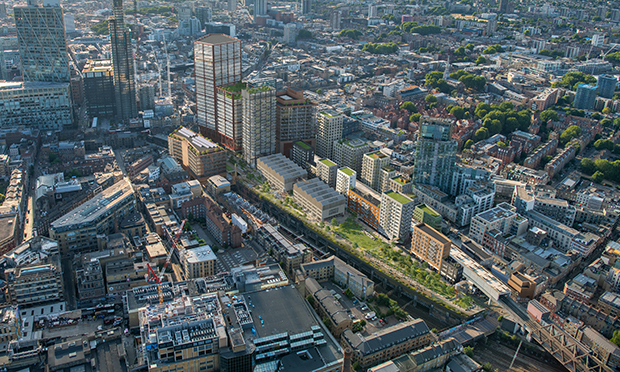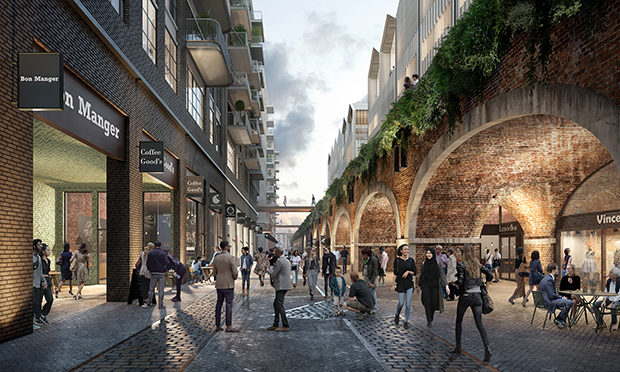Town Hall planners register objection to Bishopsgate Goodsyard scheme

The Town Hall’s planning committee last night voted in objection to the design and impact on the borough’s heritage of the forthcoming Bishopsgate Goodsyard development.
While supporting the development in principle and recognising its benefits, the committee agreed with its officers’ recommendations to register their objections to elements of the scheme as part of the advice and observations informing the final decision, which will be made by the Greater London Authority.
Councillors reserved their ire in particular for a large block to be erected on the site known as Plot 2, which Reclaim The Goodsyard campaigners have dubbed ‘Godzilla’, hitting out at fins added to the building to mitigate wind impacts, its colour, size, and its planned use as offices despite many predicting that the pandemic will cause companies to increasingly shun such environments.
Cllr Peter Snell said: “As Hackney councillors, our views should surely address Hackney, and quite honestly this does make Shoreditch High Street a bit of a mess. That cantilevered structure looks pretty ridiculous, and certainly detracts from the brickwork and the arch.
“I am also concerned why we can’t set back the upper storeys so it does not totally dominate the view going into the conservation area. Are we matching the provision that is there to the needs we have of helping local entrepreneurs survive and prosper in the new development?
“[Plot 2] sounds like a badly designed building with a whole load of growths added on the outside of it. Perhaps we ought to ask the developers what on earth happened that they ended up creating such a mess? Why didn’t they design it right in the first place? It’s pretty unacceptable in a highly visible site in Hackney.”

Image: Hammerson and Ballymore
In a report to councillors, planning officers warned of the impact on local heritage of three planned plots of the scheme, with the Goodsyard surrounded by five conservation areas and with two Grade II-listed structures on the site, as well as raising concerns over its design.
The current iteration of the scheme has been amended from a previous proposal, which would have seen residential towers of 46 and 38 storeys located on the Hackney side. This has now been replaced by a large office building.
Taller residential buildings under the scheme, which crosses over into neighbouring Tower Hamlets, have been replaced by low-rise buildings, with some structures now appearing on the open park which developers will create on the raised platform.
According to council officers, the previous residentially-led scheme was objected to due to the lack of employment provision in a priority office area, with the current scheme more commercially focused, with all the residential blocks to be built on the Tower Hamlets side.
Jonathan Moberly of the Reclaim the Goodsyard campaign said: “We believe this scheme in principle is entirely wrong for the site, and will deliver more harm than benefits to the community. We think the benefits are very slim overall.
“The proposal for Plot 1 has been around for over six years with little modification, and still the same harm and poor design are present as in the previous version of the scheme. It’s hard to exaggerate how vast it is and how much it would dwarf the street.
“The volume of the new large tower on Plot 2, which we call Godzilla, is four times that of Principal Place on the other side of Shoreditch High Street. The sheer bulk of the Goodsyard Plots 1, 2 and 3 will dominate the streetscape.
“We do not think Hackney is getting much from this scheme. Having asked for a share of the affordable housing, there is none. What you have at the western end is a large amount of office space. In the current economic climate, there must be great uncertainty about an office-led scheme of this scale.”

Campaigner Lucy Rogers added: “Existing shops in the area are already struggling, and we consider that this proposed large scale corporate retail will threaten independent small businesses, especially the character that has been built up over time drawing people to Shoreditch, Spitalfields and Bethnal Green.”
In their vote, councillors recognised the key benefits of the scheme laid out by officers, including 8,715 square metres of affordable workspace at a 60 per cent discount of market rates, which according to officers exceeds any levels secured by the borough so far and is close to matching the cumulative amount of all affordable workspace brought forward in Hackney to date.
The Town Hall has also secured an agreement that a single occupier will take on the cultural space in the building, with the hope that a “flagship operator” would take it on and establish a presence in Hackney, with some form of community work required as part of the deal.
A new east-west link will also arise connecting Shoreditch High Street and Brick Lane, as well as a park open to the public. However, officers maintained that “significant concerns” remain over the design and heritage impacts of the development.
Planning consultant Jim Pool, representing developers Hammerson & Ballymore, said “Whilst we haven’t managed to persuade everyone, we believe that the right balance has now been struck. We welcome the support offered by [Hackney’s] officers for the principles behind the masterplan, but we would go a step further.
“In our view, the outstanding concerns can readily be addressed through planning conditions. There have been statements made by some regarding the intensity of development proposed. It has been labelled on occasion as overdevelopment. However, the warning signs that come with these labels just are not there.
“We spent ten years getting to where we are today. We have been open to criticism along the way and on occasion quite deservedly so. However, on this journey we have listened, evolved and adapted wherever we could. We would welcome [Hackney’s] support.”
The consultant added that flexibility existed within the application for how the buildings may be laid out, were the market to turn away from large office developments of the kind envisaged as a result of the pandemic and its continuing fallout.
Pool went on to point to Historic England’s comments raising no objection on heritage grounds, though officers remained clear of the impact of the large buildings on the surrounding conservation areas as well as on the listed Oriel Gate.
Developers have also pointed to the constrained site, squeezed up against the railway, as necessitating the need to build upward in order “to deliver office buildings of economic consequence,” though no viability statement was produced due to the 250 affordable homes qualifying the scheme to be delivered on a ‘fast track’ route.
Hackney council officers made clear at a planning committee meeting last night that even if a viability statement had been produced, and given the constraints of the site, the “excessive scale” of the development remained a concern, with other buildings in the area not comparable to the “huge, monolithic” blocks planned.
Referring to the block on Plot 2, architect Eric Parry said: “I wanted to create a pragmatic building. I think the proportions are rather fine. You could have a heavy old building that hits the ground, so we have levitated this building. When you’re on the street, the intention with the element that moves towards the Oriel Gate is to reflect the beautiful garden underneath.
“This is a building that levitates. Wind is an issue as it is exposed. It breaks up the wind so that the garden is going to be a very nice place to be in terms of wind. It’s an elegantly integrated set of elements in my mind, and I have no embarrassment about saying that.
“In terms of the Covid question, it is not the normal sealed box. You can get out and enjoy the environment from the building on every level. I think it would be a very fine building, like the Flatiron in New York. This is a building where you could look back on and see an echo of the industrial past. I take all the criticism, but I feel extremely positive about the proposal.”
Planning committee chair Cllr Vincent Stops said: “Shoreditch is the most important conservation area we have bar none, and clearly we can see the images that officers have presented to us give cause for concern.
“We do recognise that this potential site has been around since 1964, and it is a very difficult site to bring forward. Had we seen the viability, we might have been more convinced, but that does not mitigate some of the issues that they have pointed to.”
A spokesperson for the Hammerson and Ballymore joint venture said:“We welcome Hackney Council’s support in principle for our revised planning application for The Bishopsgate Goodsyard, while acknowledging the council has some outstanding concerns.
“Our plans, which will be determined by the Mayor of London, will provide one of the largest provisions of affordable workspace in London, delivering space for a range of businesses, from entrepreneurs and start-ups, to scale-ups and SMEs. This will support Shoreditch’s growth and deliver on many of the council’s objectives for this strategically important brownfield site.
“We have listened carefully to feedback on our original proposal. After extensive consultation with Hackney and Tower Hamlets councils, the local community and the Greater London Authority, we believe our revised plans, which greatly reduce the height and density across the site, provide for a balanced mixed-use scheme that will deliver a huge range of benefits to the local area and London long into the future.
“We believe our designs, which reflect the large number of constraints across the site, make possible the wide range of benefits that the scheme provides. As well as creating over 11,000 jobs, our revised scheme will deliver 500 new homes, of which 50 per cent will be affordable, alongside one of central London’s largest new public parks. We look forward to highlighting these benefits to Tower Hamlets council members, and subsequently the Mayor of London.”
